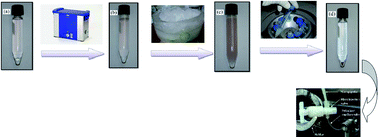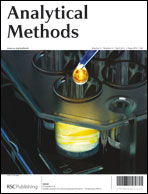A new methodology ultrasound assisted cold-induced aggregation microextraction (USA-CIAME) was developed for the determination and extraction of ultra trace levels of Au3+ from aqueous hydrochloric acid solutions by pure ionic liquid (IL), in the absence of chelating agents. The extraction behaviour of metal ions by [Hmim]PF6 was particularly studied. Moreover, the stripping of metal ions from the IL phase was investigated. Au3+ in IL phase can be quantitatively recovered by NaPF6. Recycle testing indicated that IL loss can be avoided by the additon of [Hmim]+ to the initial AuCl4− solutions before extraction and/or using PF6− solutions for stripping. The main factors affecting Au3+ extraction, the amount of IL, the pH of the sample solutions, and the chloride ion concentration on extraction efficiencies were carefully studied. A linear calibration was obtained for 1.5 to 200 μg L−1 of Au3+ and the limit of detection was 0.59 μg L−1. The validation of this method was done by recovery and determination of trace amount of gold in river, sea water and geological samples with satisfactory results.

You have access to this article
 Please wait while we load your content...
Something went wrong. Try again?
Please wait while we load your content...
Something went wrong. Try again?


 Please wait while we load your content...
Please wait while we load your content...